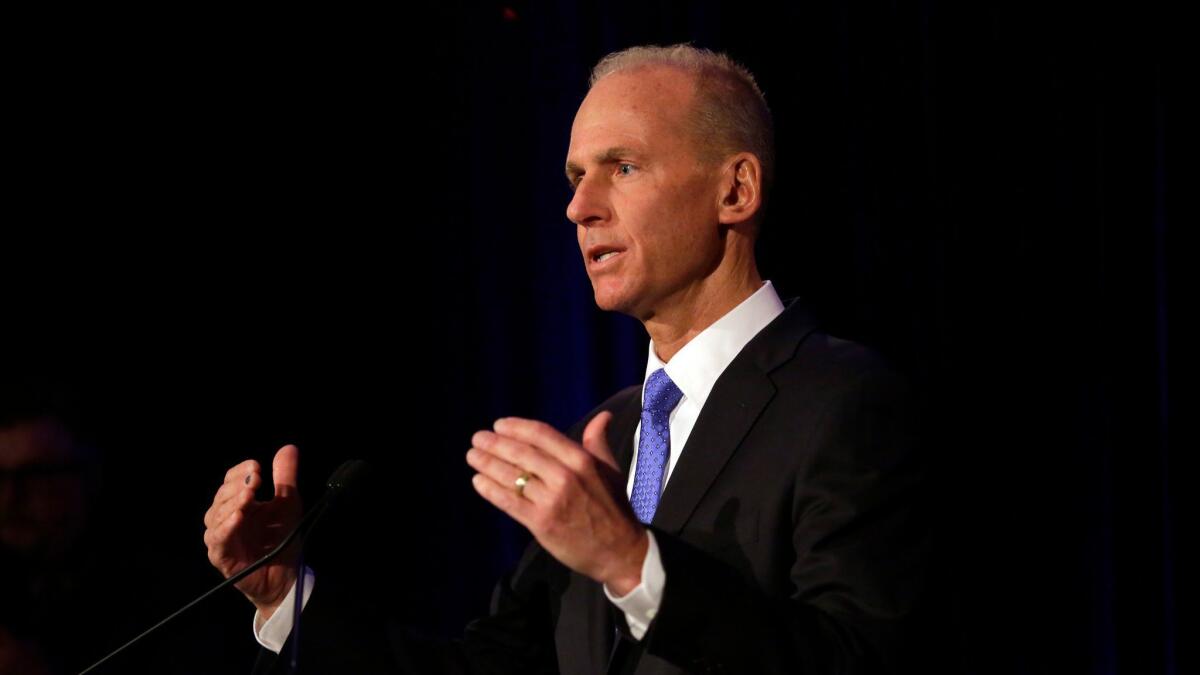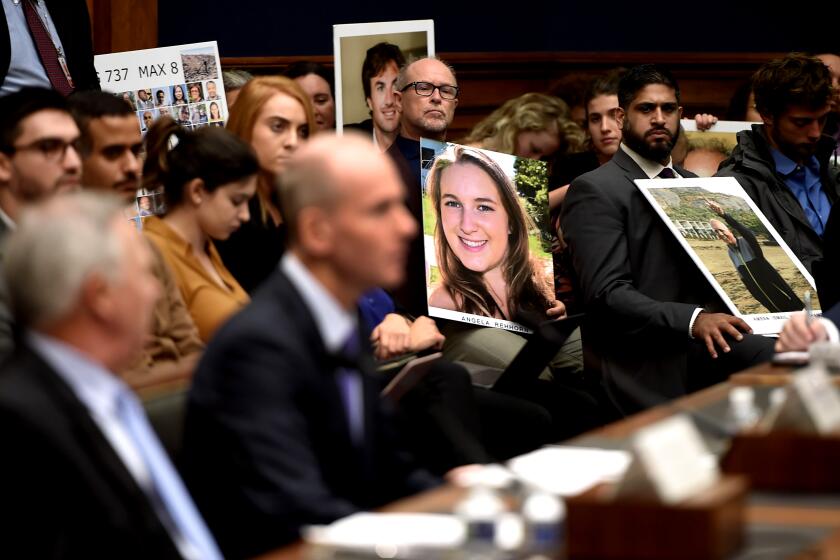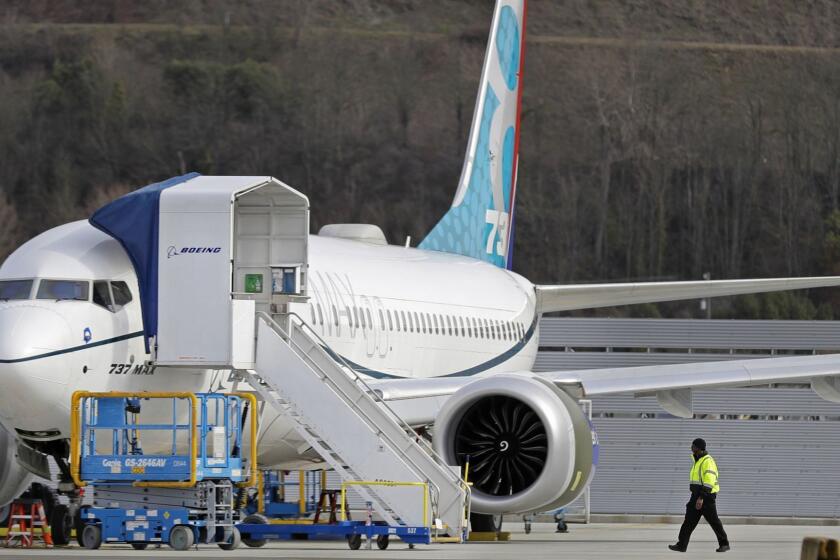Boeing fine-tunes software, creates safety group as it readies 737 Max for return

Boeing Co. is in the “endgame” of preparing its 737 Max to return to the commercial market after two deadly crashes prompted a global grounding more than six months ago, Chief Executive Dennis Muilenburg said in an interview.
The plane maker is fine-tuning a software upgrade for the Max’s flight-control computers in its simulation lab and girding for the evaluation of a final version by pilots — while discussing the timing of the certification flight with U.S. officials. That’s the final hurdle before the Federal Aviation Administration determines whether the flying ban can be lifted, Muilenburg said Monday.
The CEO is also shaking up Boeing’s organizational structure to sharpen its focus on safety after the Ethiopian and Lion Air tragedies, although the moves will fall short of the executive overhaul sought by some victim advocates.
“I’m very confident in the team we have,” Muilenburg said, pointing to a series of personnel changes the company has quietly made since March. The new appointments include the head of the 737 program, a vice president of engineering for the commercial airplane business and its supply-chain chief. “We’re always putting our best people in the toughest assignments, and that’s the case here.”
Acting on a recommendation from the board, Muilenburg is creating a new product and services safety organization to centralize responsibilities across the plane maker’s business and operating units. The new group will be run by Beth Pasztor, a 34-year Boeing veteran who will report to the company’s chief engineer and a new aerospace board committee.
Pasztor will have responsibility for all aspects of product safety, including investigating concerns raised anonymously by employees, Boeing said in a statement Monday. The company’s accident investigation team, safety review boards and engineering and technical experts who represent the Federal Aviation Administration in aircraft certification will all report to Pasztor, who previously oversaw product safety at Boeing’s jetliner division.
“Beth is a proven leader, she’s a collaborator,” Muilenburg said in an interview from the 36th-floor executive suite in the company’s Chicago office tower. He also considered external candidates before deciding that Pasztor’s deep knowledge of Boeing would give her a running start. “She, from a technical qualification standpoint, is the best.”
Muilenburg is under pressure to show airlines, travelers and global regulators that safety is woven into the century-old manufacturer’s designs and culture. Both have been called into question given the lapses that have prompted regulators to ground two brand-new Boeing jetliners this decade.
The company had already rung up $8.3 billion in Max-related expenses through July, and the costs of maintaining production and compensating customers are certain to grow the longer the grounding lasts.
The final steps to lifting the ban are clearly defined, and timing will be determined by the FAA, Muilenburg said. Once a final version of the flight control computer update is ready, Boeing will invite airline pilots to test-fly it in the company’s engineering simulators known as e-cabs. A separate team of pilots will review the company’s updated training material. After that FAA pilots will test the changes in a Boeing 737 Max bristling with sensors and other flight-testing equipment.
“That’s the certification endgame,” Muilenburg said. “We’re still marching to a timeline of return to service early in the fourth quarter, but I want to reiterate the timing will be determined by regulators.”
The Max hasn’t flown commercially since just after the March crash of an Ethiopian Airlines jet. A Lion Air plane went down off the coast of Indonesia in October. In both disasters, a once-obscure flight-control system went haywire, nudging the planes’ noses down until pilots were overwhelmed. In 2013, the 787 Dreamliner was banned for three months after fires on two planes from lithium-ion batteries.
A set of stairs may have never caused so much trouble in an aircraft.
Directors last week signaled that they would closely monitor the company’s progress under Muilenburg. A new board committee is devoted to overseeing the safe design, development and production of the company’s aerospace product lineup. “Safety-related experience” will be a criterion to be considered in choosing future directors.
“This is an engineering company, it needs an engineering culture and engineering management,” aerospace analyst Richard Aboulafia said last week. “It deviated pretty far from this at the time when the Max was being developed.”
The U.S. National Transportation Safety Board last week called for a renewed focus on how a cacophony of flight-deck alerts can distract and overwhelm pilots. The agency’s report on the Max tragedies also provided clues to one of the mysteries of the disasters: how Boeing safety assessments for a software system linked to the crashes could still comply with FAA design principles.
Boeing’s simulator tests of the Maneuvering Characteristics Augmentation System focused on pilots’ response to indications that a motor on the horizontal stabilizer was pushing the plane’s nose down without their input.
But the hazard tests never examined specific failure modes that could cause MCAS to kick on — including failure of a key sensor that tripped multiple cockpit warnings and bewildered pilots on the Lion Air and Ethiopian Airlines flights.
Boeing, following recommendations from the board last week, will have the company’s tens of thousands of engineers report to the company’s chief engineer, Greg Hyslop. That will promote a more consistent approach to meeting operational priorities, while enabling senior managers to spot and elevate talented engineers, Boeing said. The move mirrors an earlier restructuring of finance professionals, who now report directly to Boeing Chief Financial Officer Greg Smith.
Muilenburg said he doesn’t expect the structural shift to substantially change the day-to-day work of those carrying out design and testing. But connecting the technical experts to other engineers across the company will create a new, informal network they can consult when problems crop up, he said.
He is also expanding Boeing’s safety management system and safety review boards, which are now led by senior executives, including Hyslop and business division chiefs. Boeing has also invested in enhanced flight simulation and computing capabilities. Software engineers in recent weeks have run 390,000 flight hours — the equivalent of flying 45 years — on the 737 Max.
In addition, the company is already pouring money into researching the design of future flight decks to account for human factors. Boeing is planning future investment in aerospace talent — both within the company and outside it, as it renews its focus on training pilots and mechanics and attracting students to science and engineering, Muilenburg said.
More to Read
Inside the business of entertainment
The Wide Shot brings you news, analysis and insights on everything from streaming wars to production — and what it all means for the future.
You may occasionally receive promotional content from the Los Angeles Times.












